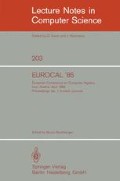Abstract
This paper is divided into three sections. The first gives an overview of the presently available and emerging dialects of LISP and how design decisions within them affect symbolic algebra. The second discusses recent developments, in particular, Common LISP, subsetting, portability, pure language research and mixed paradigm systems. The third part is devoted to what is happening in specialised LISP hardware in Japan, in the United States and in Europe. The subject matter of each of these three sections is so tightly interwoven however that the detailed discussion of some material may be postponed until a later section although to some readers it might seem appropriate for inclusion earlier. It should also be mentioned that this is a survey: therefore the items have been selected for mention on the grounds of interest rather than completeness.
Preview
Unable to display preview. Download preview PDF.
References
Baker, H. G., Shallow Binding in LISP 1.5, CACM July 1978, Vol 21, No. 7, pp565–569
Blair, F. W., The Definition of LISP 1.8 + 0.3i, IBM Thomas J Watson Research Center Internal Report
Bobrow, D. G. & Wegbreit, B., A Stack Model and Implementation of Multiple Environments, CACM October 1973, Vol 16, No. 10, pp591–603
Bobrow, D. G. & Stefik, M., The LOOPS Manual, Xerox Corporation (PARC), 1983
Bowen, D. L., Byrd, L. M., & Clocksin, W. F., A Portable Prolog Compiler, Logic Programming Workshop '83, (Universidade Nova de Lisboa) June 1983, pp. 74–83
Brooks, R. A. & Gabriel, R. P., A Critique of Common LISP, Proceedings of 1984 ACM Symposium on LISP and Functional Programming, pp1–8
Chailloux, J., Devin, M. & Hullot, J-M., LeLISP, a Portable and Efficient LISP System, Proceedings of 1984 ACM Symposium on LISP and Functional Programming, pp113–122
Chikayama, T., UTILISP Manual, Technical Report METR 81–6, Mathematical Engineering Section, Faculty of Engineering, University of Tokyo
Fateman, R. J., The MACSYMA Reference Manual for the VAX, University of California at Berkeley, 1980
Fitch, J. P. & Norman, A. C., Implementing LISP in a High-Level Language, Software Practice and Experience 1977, vol 7, pp713–725
Fitch, J. P & Padget, J. A., A Pure And Really Simple Initial Functional Algebraic Language, Proceedings of EUROSAM '84, published as Springer Verlag (LNCS) #174, pp148–158
Foderaro, J. K. & Slower, K. L., The Franz LISP Manual, University of California at Berkeley, 1980
Frick, I. B., SHEEP User's Manual, Institute of Theoretical Physics, University of Stockholm, Sweden, 1975
Friedman, D. P., Haynes, C. T., Kohlbecker, E. & Wand, M., The Scheme-84 Reference Manual, Indiana University Technical Report No. 153
Gabriel, R. P., Benchmarking LISP Systems, Stanford University, Dept. of Computer Science, Technical Report
Goto, E., + 8, Design of a LISP machine — FLATS, Proceedings of 1982 ACM Symposium on LISP and Functional Programming, pp208–215
Goto, E. & Shimizu, K., Architecture of a Josephson Computer (FLATS-2), Proceedings of RSYMSAC II, RIKEN, Tokyo, August 1984
Griss, M. L., Benson, E. & Maguire, G. Q., PSL: A Portable LISP System, Proceedings of 1982 ACM Symposium on LISP and Functional Programming, pp88–97
Hayashi, H., Hattori, A. & Akimoto, H., ALPHA: A High-perfomance LISP Machine Equipped with a new Stack Structure and Garbage Collection System, IEE 1983 Conference Proceedings of the 10th Annual International Symposium on Computer Architecture, pp342–348
Hearn, A. C., REDUCE-3 Manual, Rand Corporation, Santa Monica, USA
Hibino, Y., Watanabe, K. & Osato, N., The architecture of LISP machine ELIS. SIGSYM report, 24, IPSJ, June 1983
Jenks, R. D., A Primer: 11 Keys to new Scratchpad, Proceedings of EUROSAM '84, published by Springer Verlag (LNCS) #174, pp123–147
Kahn, K. & Carlsson, M., How to Implement Prolog on a LISP Machine, in Implementations of Prolog, edited by J. A. Campbell, Ellis Horwood, 1984
Marti, J. B., The UOLISP Reference Manual, North-West Computer Algorithms, Santa Monica, CA
Marti, J. B., Private communication
Mellish, C. S. & Hardy, S., Integrating Prolog in the POPLOG Environment, in Implementations of Prolog, edited by J. A. Campbell, Ellis Horwood, 1984
Moon, D., Garbage collection in a Large LISP System, Proceedings of 1984 ACM Symposium on LISP and Functional Programming, pp235–246
Moses, J., The function of FUNCTION, SIGSAM Bulletin 1970, Vol 4. pp13–27
Novak, G. S., GLISP User's Manual, University of Texas at Austin, Dept. of Computer Sciences, Technical Report TR-83-25
Okuno, H. G., Takeuchi, I., Osato, N., Hibino, Y. & Watanabe, K., TAO: A Fast Interpreter-Centered LISP System on LISP Machine ELIS, Proceedings of 1984 ACM Symposium on LISP and Functional Programming, pp140–149
Padget, J. A. & Fitch, J. P., The Rationale of LIER: A Considered LISP, Proceedings of RSYMSAC II, RIKEN, Tokyo, August 1984
Pavelle, R., & Wang, P. S., MACSYMA from F to G, to appear in Vol 1. #1 of Journal of Symbolic Computation, North Holland (Amsterdam).
Pitman, K. M., The Revised MACLISP Manual, MIT Al-Lab, May 1983
Smith, B. C., Reflection and Semantics in LISP, Proceedings 1984 ACM POPL Conference, pp23–35
Steele, G. L., Common LISP Reference Manual, Digital Press, Cambridge, Massachussets
Sussman, G. J. & Steele, G. L., SCHEME: An Interpreter for Extended Lambda Calculus, MIT-AI Memo #349
Teitelman, W., The InterLISP Manual, Xerox Corporation (PARC), 1978
Warren, D. H. D., An Improved Prolog Implementation which Optimises Tail Recursion. Research Paper 156. Department of Artifical Intelligence, University of Edinburgh, 1980
Weinreb, D. & Moon, D., LISP Machine Manual, MIT Al-Lab, 1981
White, J. L., NIL — A Perspective, Proceedings 1979 MACSYMA User's Conference, pp190–199
Author information
Authors and Affiliations
Editor information
Rights and permissions
Copyright information
© 1985 Springer-Verlag Berlin Heidelberg
About this paper
Cite this paper
Padget, J. (1985). Current developments in LISP. In: Buchberger, B. (eds) EUROCAL '85. EUROCAL 1985. Lecture Notes in Computer Science, vol 203. Springer, Berlin, Heidelberg. https://doi.org/10.1007/3-540-15983-5_4
Download citation
DOI: https://doi.org/10.1007/3-540-15983-5_4
Published:
Publisher Name: Springer, Berlin, Heidelberg
Print ISBN: 978-3-540-15983-4
Online ISBN: 978-3-540-39684-0
eBook Packages: Springer Book Archive

